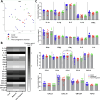Modulating cytokine microenvironment during T cell activation induces protective RSV-specific lung resident memory T cells in early life in mice
- PMID: 39749186
- PMCID: PMC11688237
- DOI: 10.1038/s44298-024-00073-x
Modulating cytokine microenvironment during T cell activation induces protective RSV-specific lung resident memory T cells in early life in mice
Abstract
Maternal immunisation against respiratory viruses provides protection in early life, but as antibodies wane, there can be a gap in coverage. This immunity gap might be filled by inducing pathogen-specific lung tissue-resident T cells (TRM). However, the neonatal mouse lung has a different inflammatory environment to the adult lung which affects T cell recruitment. We compared the factors affecting viral-specific TRM recruitment in the lungs of adult or neonatal mice. In contrast to adulthood, we demonstrated that RSV or influenza infection in neonatal mice recruited fewer TRM to the lungs. This was associated with reduced lung levels of CCL5 and CXCL10. Co-administration of CCL5 or CXCL10 at the time of primary T cell activation significantly increased RSV-specific TRM in the lung, protecting mice upon reinfection. These chemokine differences were reflected in responses to infection in human cord blood. Here we show a critical role for CCL5 and CXCL10 in the induction of lung TRM and a possible strategy for boosting responses.
Keywords: Immunopathogenesis; Vaccines.
© The Author(s) 2024.
Conflict of interest statement
Competing interestsThe authors declare no competing interests.
Figures





Similar articles
-
Increased innate immune activation induces protective RSV-specific lung-resident memory T cells in neonatal mice.Mucosal Immunol. 2023 Oct;16(5):593-605. doi: 10.1016/j.mucimm.2023.05.012. Epub 2023 Jul 21. Mucosal Immunol. 2023. PMID: 37392972
-
Conserved T-cell epitopes of respiratory syncytial virus (RSV) delivered by recombinant live attenuated influenza vaccine viruses efficiently induce RSV-specific lung-localized memory T cells and augment influenza-specific resident memory T-cell responses.Antiviral Res. 2020 Oct;182:104864. doi: 10.1016/j.antiviral.2020.104864. Epub 2020 Jun 22. Antiviral Res. 2020. PMID: 32585323 Free PMC article.
-
Tissue-Resident Memory T Cells in the Lungs Protect against Acute Respiratory Syncytial Virus Infection.Immunohorizons. 2021 Feb 3;5(2):59-69. doi: 10.4049/immunohorizons.2000067. Immunohorizons. 2021. PMID: 33536235 Free PMC article.
-
Pulmonary resident memory T cells in respiratory virus infection and their inspiration on therapeutic strategies.Front Immunol. 2022 Aug 12;13:943331. doi: 10.3389/fimmu.2022.943331. eCollection 2022. Front Immunol. 2022. PMID: 36032142 Free PMC article. Review.
-
Lung tissue-resident memory T cells: the gatekeeper to respiratory viral (re)-infection.Curr Opin Immunol. 2023 Feb;80:102278. doi: 10.1016/j.coi.2022.102278. Epub 2022 Dec 22. Curr Opin Immunol. 2023. PMID: 36565508 Free PMC article. Review.
References
-
- Kampmann, B. et al. Bivalent prefusion F vaccine in pregnancy to prevent RSV illness in infants. N. Engl. J. Med.388, 1451–1464 (2023). - PubMed
-
- Villafana, T., Falloon, J., Griffin, M. P., Zhu, Q. & Esser, M. T. Passive and active immunization against respiratory syncytial virus for the young and old. Expert Rev. Vaccines16, 1–13 (2017). - PubMed
-
- UKHSA. (2024).
Grants and funding
LinkOut - more resources
Full Text Sources
Miscellaneous

